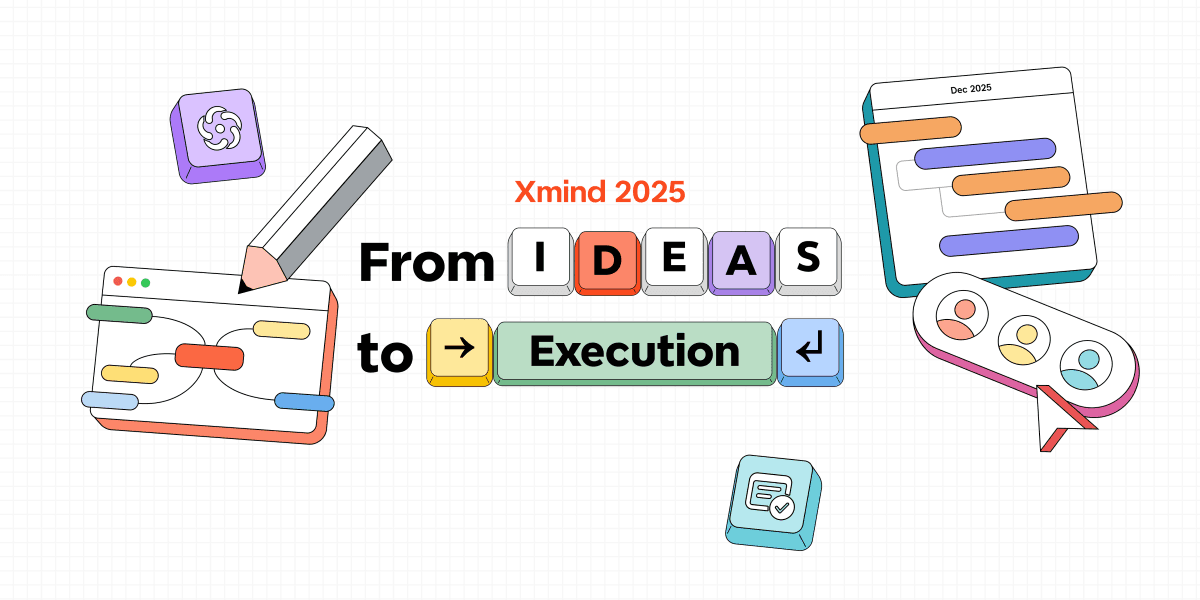09.09.2025
Projektmanagement-Lebenszyklus erklärt: Ein pragmatischer Leitfaden für 2025
Ein gut strukturierter Projektmanagement-Lebenszyklus hilft Ihnen, Ihre Projekte erfolgreich von Anfang bis Ende zu führen. Der Lebenszyklus umfasst fünf Schlüsselphasen: Initiierung, Planung, Ausführung, Überwachung und Kontrolle sowie Abschluss. Projektmanagementexperten sind sich einig, dass diese Phasen die Grundlagen einer vollständigen Roadmap bilden. Diese Roadmap kennzeichnet klar den Start- und Endpunkt Ihres Projekts mit spezifischen Kontrollpunkten im gesamten Verlauf.
Die fünf Phasen sorgen für methodischen Fortschritt und gewünschte Ergebnisse, unabhängig von der Größe Ihres Projekts – von kleineren Teaminitiativen bis hin zu großen Unternehmensprojekten. Möchten Sie ein Experte im Management des Projektlebenszyklus werden? Sie können beginnen, indem Sie Ihre Projektphasen mit Xmind visualisieren. Dieses Tool hilft Ihnen, Ihren Ansatz im Projektmanagement durch eine geeignete Struktur zu verändern.
Was ist der Projektmanagement-Lebenszyklus?
Der Projektmanagement-Lebenszyklus ist eine schrittweise Anleitung, die ein Projekt von der ersten Idee bis zu seinem endgültigen Abschluss leitet. Stellen Sie es sich wie eine strukturierte Karte vor: Sie zeigt, wo das Projekt beginnt, wie es voranschreitet und wie es offiziell abgeschlossen wird.
In der Praxis ist es mehr als nur eine Checkliste. Der Lebenszyklus gibt Projektmanagern und Teams einen klaren Rhythmus vor — was es einfacher macht, Ziele zu setzen, realistisch zu planen, Fortschritte zu verfolgen und aus den Ergebnissen zu lernen. Er bildet das Rückgrat des Projektmanagements selbst: Ohne ihn kann das Management eines Projekts wie eine Fahrt ohne Richtung wirken. Mit ihm gewinnen Teams Klarheit, Vertrauen und ein gemeinsames Verständnis darüber, wie sie gemeinsam Erfolg erreichen können.
Verständnis der 5 Phasen des Projektlebenszyklus
Der Erfolg des Projektmanagements hängt von fünf Schlüsselphasen ab. Jede Phase baut auf der vorhergehenden auf. Dies schafft ein solides Gerüst, das Ihr Projekt von Anfang bis Ende führt.
1. Initiierung: Definition des Projekts und seiner Ziele
Der Grundstein Ihres Projekts wird mit der Definition seines Zwecks, Umfangs und Geschäftswerts gelegt. Dieser erste Schritt sagt Ihnen, ob das Projekt sinnvoll ist. Sie erstellen eine Projektcharta, die das offizielle Okay gibt und die Befugnisse des Projektmanagers festlegt. Die Charta listet wesentliche Anforderungen, Meilensteine und Erfolgsindikatoren auf, die das gesamte Projekt leiten.
Darüber hinaus identifizieren Sie die Stakeholder, um zu verstehen, wer vom Projekt betroffen ist oder beteiligt sein wird. Eine detaillierte Stakeholder-Analyse hilft Ihnen, Erwartungen zu setzen und Unterstützung vom Kernteam zu erhalten.
2. Planung: Erstellung einer Roadmap zum Erfolg
Die Planungsphase beginnt nach der Projektfreigabe. Sie erarbeiten einen detaillierten Plan, der Aufgaben, Zeitpläne, Abhängigkeiten und Meilensteine zeigt. Traditionelle Methoden benötigen oft fast die Hälfte der gesamten Projektzeit nur für diese Phase.
Ihre Planungswerkzeuge sollten eine Arbeitsstrukturaufgliederung (WBS), einen Ressourcenallokationsplan, einen Kommunikationsmanagementplan und eine Risikobewertung beinhalten. Diese helfen allen, das Projekt klar zu sehen, zu wissen, was zu erwarten ist und sich auf Herausforderungen vorzubereiten, bevor die Arbeit beginnt.
3. Ausführung: Pläne in die Tat umsetzen
Die Ausführungsphase setzt Ihren Plan in Bewegung. Projektmanager koordinieren Ressourcen, kümmern sich um Arbeitsabläufe und stellen sicher, dass die Qualität hoch bleibt. Diese längste Phase erfordert eine sorgfältige Handhabung von Prozessen, Menschen und Kommunikation.
Teamgeist und klare Kommunikation werden in dieser Phase entscheidend. Regelmäßige Updates und Offenheit fördern Vertrauen und zeigen schneller Probleme auf, die gelöst werden müssen.
4. Überwachung & Kontrolle: Auf Kurs bleiben
Überwachung und Kontrolle laufen parallel zur Ausführung, um den Fortschritt im Vergleich zum Plan zu verfolgen. Projektmanager betrachten den Abschluss von Aufgaben, die Ressourcennutzung, das Budget und die Qualitätsmetriken, um den Gesundheitszustand des Projekts zu überwachen.
Schnelle Maßnahmen bringen das Projekt wieder auf Kurs, wenn die Überwachung Probleme aufzeigt. Studien zeigen, dass Projekte mit starken Überwachungssystemen Budgetüberschreitungen um 25% reduzieren und die Ressourcennutzung um 30% erhöhen.
5. Abschluss: Projekt beenden und Ergebnisse überprüfen
Die letzte Phase schließt das Projekt offiziell ab. Sie benötigen die formale Annahme der Ergebnisse, geben Ressourcen frei, speichern Dokumentationen und übergeben das Projekt an die Betriebs- oder Supportteams.
Der wertvollste Teil ergibt sich aus dem Lernen, was gut funktioniert hat und was verbessert werden muss. Diese Lektionen machen zukünftige Projekte besser und bereichern die Wissensbasis Ihres Unternehmens.
Verschiedene Modelle des Projektlebenszyklus

Der Projektmanagement-Lebenszyklus umfasst fünf Schlüsselphasen, die Teams je nach gewählter Methodik unterschiedlich anordnen und angehen können. Sie können den richtigen Ansatz wählen, der Ihren Projektanforderungen entspricht, indem Sie diese Modelle kennenlernen.
Agil: Iterativ und flexibel
Agil teilt Projekte in kleine, handhabbare Iterationen, sogenannte Sprints, die normalerweise zwei bis vier Wochen dauern. Das Modell hebt sich von traditionellen Methoden ab, indem es durchgängige Zusammenarbeit und Anpassungsfähigkeit während des gesamten Projektlebenszyklus in den Vordergrund stellt. Teams können maximalen Wert gegenüber den geschäftlichen Prioritäten innerhalb der Zeit- und Budgetbeschränkungen liefern.
Die Werte von Agil stellen Menschen über Prozesse, funktionierende Lösungen vor Dokumentation und die Zusammenarbeit mit dem Kunden über Verträge. Teams reagieren auf Veränderungen, anstatt starren Plänen zu folgen. Aktuelle Daten zeigen, dass im vergangenen Jahr 56% der Projektprofis agile Modelle eingesetzt haben, was die Beliebtheit dieses Ansatzes unterstreicht.
Wasserfall: Linear und strukturiert
Wasserfall folgt einem sequenziellen, unidirektionalen Fluss, bei dem Teams jede Phase abschließen müssen, bevor sie zur nächsten übergehen. Winston W. Royce definierte diesen Ansatz, der am besten für Projekte mit klaren Anforderungen und vorhersehbaren Ergebnissen funktioniert.
Typischerweise verbringen Teams 20-40% der Projektzeit in den ersten zwei Phasen des Wasserfalls. Die Codierung beansprucht 30-40%, und das Testen und die Implementierung füllen die verbleibende Zeit. Dieser gut strukturierte Ansatz bietet klare Meilensteine und detaillierte Dokumentation. Projekte, die strikte Compliance und Vorhersehbarkeit erfordern, profitieren am meisten von diesem Modell.
Iterativ: Wiederholende Zyklen zur Verfeinerung
Das iterative Modell nutzt Elemente aus beiden Ansätzen, indem es Projekte in wiederholbare Zyklen unterteilt. Teams lernen aus jeder Iteration und bauen auf diesen Lektionen auf. Dies schafft Raum für Verbesserungen ohne die Flexibilität von Agil oder die Struktur von Wasserfall.
Teams beginnen damit, die übergeordneten Projektziele zu planen und durch Zyklen von Design, Implementierung, Test und Bewertung zu gehen. Das Feedback jedes Zyklus formt die nächste Iteration. Dieser Ansatz reduziert Risiken und optimiert Prozesse, was zu zufriedeneren Stakeholdern führt.
Häufige Herausforderungen im Projektlebenszyklusmanagement
Gut geplante Projekte stehen dennoch vor großen Herausforderungen im gesamten Projektmanagement-Lebenszyklus. Eine frühzeitige Identifikation dieser Herausforderungen hilft Ihnen, sie besser zu bewältigen.
Ressourcenbeschränkungen und Allokationsprobleme
Ressourcenallokationsprobleme können den Zeitrahmen des Projekts aus dem Gleichgewicht bringen und die Moral des Teams beeinträchtigen. Studien zeigen, dass überlastete Ressourcen Burnout, Produktivitätsverlust und Qualitätsprobleme erleben. Teams mit ungenutzten Ressourcen verschwenden Kapazitäten und erhöhen die Kosten.
Um eine Überbelegung der Ressourcen zu verhindern:
Bewerten Sie die Arbeitskapazität in frühen Planungsphasen
Erstellen Sie Backup-Pläne für potenzielle Ressourcenengpässe
Überwachen Sie die Arbeitsverteilung und passen Sie sie proaktiv an
Kommunikationsabbrüche innerhalb der Teams
Projektfehler resultieren zu 40% aus schlechter Kommunikation. Etwa 32% der Fachleute betrachten Kommunikation als ihre größte Herausforderung im Projektmanagement. Diese Abbrüche treten als schlechte Informationsweitergabe, Missverständnisse und schwache Zusammenarbeit auf.
Mangelnde Stakeholder-Einbindung
Das Stakeholder-Management spielt eine entscheidende Rolle für den Erfolg, wird aber von Teams oft als zweitrangige Aktivität betrachtet. Nur 25% der Projektbeteiligten engagieren sich vollständig für Veränderungen. Die restlichen 75% akzeptieren entweder passiv oder widersetzen sich aktiv. Ohne angemessene Beteiligung könnten die Stakeholder die Projektziele missverstehen. Dies führt zu verzögerten Entscheidungen und schlechter Ressourcenallokation.
Wie Xmind in den 5 Phasen des Projektmanagements hilft
Xmind erleichtert die Visualisierung des Projektmanagements mit leistungsstarken Mind-Mapping-Tools. Die Plattform bietet spezifische Lösungen, die Ihre Projekte durch alle fünf Phasen begleiten.
Klarstellung von Projektzielen und Stakeholdern in der Initiierungsphase
Am Anfang eines Projekts kämpfen Teams oft mit der Ausrichtung auf Ziele, Stakeholder und dem, was Erfolg wirklich bedeutet. Hier wird Xmind's Mind Map unverzichtbar. Die radiale Struktur lässt Brainstorming-Sitzungen intuitiv wirken — Ideen entwickeln sich natürlich aus einer zentralen Vision, während Beziehungen sichtbar bleiben. Dies hilft, widersprüchliche Prioritäten, fehlende Stakeholder oder unklare Rollen zu erkennen, bevor sie zu Risiken werden. Mit Pitch Mode kann der initiale Fahrplan klar geteilt werden, um sicherzustellen, dass alle von Anfang an auf der gleichen Seite sind.
Strukturierung der Arbeit und Definition von Abhängigkeiten in der Planungsphase
In der Planungsphase beginnt die Komplexität zuzunehmen — Aufgaben, Abhängigkeiten, Zeitpläne und Ressourcen müssen entwirrt werden. Xmind macht dies einfacher mit Werkzeugen wie Timeline und Beziehungslinie. Projektmanager können eine Arbeitsstrukturaufgliederung (WBS) in Mind-Map-Form erstellen, mit Verbindungslinien Abhängigkeiten hinzufügen und Marker für Prioritäten oder Zuweisungen verwenden. Das Ergebnis ist ein klarer, visueller Plan, der dem Team hilft, Engpässe vorherzusehen, die Arbeitsbelastung auszugleichen und Ausrichtung zu halten, bevor die Umsetzung beginnt.
Koordinierung der Teams und Teilen von Fortschritten in der Ausführungsphase
Sobald das Projekt in vollem Gange ist, bleibt die Herausforderung, alle abgestimmt zu halten. Xmind's Team Workspace bietet ein gemeinsames Umfeld, in dem Mitglieder auf gemeinsame Karten zugreifen, zusammenarbeiten und die Arbeit organisieren können. Innerhalb des Workspaces können Benutzer Karten in Echtzeit gemeinsam bearbeiten und Kommentare hinterlassen, indem sie Teamkollegen markieren, um Fragen oder Feedback sofort zu klären. Stakeholder erhalten sofortigen Einblick, wer wofür verantwortlich ist, und welche Meilensteine oder Aufgaben abgeschlossen wurden. Diese Transparenz hilft, Missverständnisse zu vermeiden und stellt sicher, dass alle mit einem klaren Verständnis des Fortschritts gemeinsam vorankommen.
Risiken verfolgen und Pläne im Überwachungs- und Kontrollstadium anpassen
Da Projekte sich entwickeln, sind unvorhergesehene Risiken und sich ändernde Prioritäten unvermeidlich. Mit Xmind's To-do-Feature können Teams jederzeit den Überblick über Aufgaben, Fristen und Verantwortlichkeiten behalten. Todos ermöglichen es Ihnen, den Fortschritt in Echtzeit zu verfolgen, den Status sofort zu aktualisieren und Elemente schnell zu erkennen, die Gefahr laufen, verzögert zu werden. In Kombination mit visuellen Tools wie Matrix oder Ishikawa-Diagrammen können Risiken und Grundursachen direkt mit umsetzbaren Aufgaben verknüpft werden. Dies erleichtert es, Minderungsmaßnahmen zuzuweisen, die Ausführung zu überwachen und Pläne anzupassen, wenn sich die Umstände ändern — um sicherzustellen, dass Projekte unter Kontrolle bleiben und kleine Probleme nicht zu großen Rückschlägen wachsen.
Lektionen und Ergebnisse in der Abschlussphase erfassen
Wenn ein Projekt abgeschlossen wird, geht es nicht nur darum, das letzte Kästchen abzuhaken - es geht darum, Lektionen zu erfassen und den Wert zu bewahren. Xmind hilft Teams beim Nachdenken mit Retrospektiven-Karten, die Erfolge, Herausforderungen und Erkenntnisse für zukünftige Verwendung zusammenfassen. Ergebnisse können visuell organisiert und in mehreren Formaten (PDF, PNG, Markdown oder Microsoft Office) für eine reibungslose Übergabe exportiert werden. Diese visuellen Aufzeichnungen werden mehr als nur Dokumentation - sie bilden eine Wissensbasis, die die Projektmanagementpraktiken im gesamten Unternehmen stärkt.
Bereit, Ihr Projektmanagement zu verbessern? Probieren Sie Xmind aus.
Schlussfolgerung
Die Beherrschung des Projektmanagement-Lebenszyklus führt zu erfolgreicheren Projektergebnissen. Ein strukturierter Ansatz zur Bewältigung von Projekten jeder Größe kommt aus dem Verständnis jeder Phase — von der Initiierung bis zum Abschluss. Das Fünf-Phasen-Rahmenwerk bildet Ihr Fundament für den Erfolg, egal ob Sie Agil für Flexibilität, Wasserfall für Struktur oder ein iteratives Modell für kontinuierliche Verbesserung wählen.
Xmind erweist sich als ein wertvolles Werkzeug in den Phasen des Projektlebenszyklus. Dieses vielseitige Tool macht Ziele in der Initiierung klar, strukturiert die Arbeit während der Planung, koordiniert Teams während der Ausführung, verfolgt Risiken während der Überwachung und erfasst wesentliche Lektionen während des Abschlusses. Möchten Sie Ihren Projektmanagement-Ansatz verbessern? Probieren Sie Xmind aus und sehen Sie, wie visuelle Organisation Ihren Projektlebenszyklus von Anfang bis Ende optimieren kann.
FAQs
F1. Was sind die Hauptphasen des Projektmanagement-Lebenszyklus?
Der Projektmanagement-Lebenszyklus besteht aus fünf Hauptphasen: Initiierung, Planung, Ausführung, Überwachung und Kontrolle sowie Abschluss. Jede Phase baut auf der vorherigen auf und schafft ein umfassendes Rahmenwerk, das Projekte von der Konzeption bis zum Abschluss leitet.
F2. Wie unterscheidet sich das Agile-Projektmanagementmodell von traditionellen Ansätzen?
Agil ist ein iterativer und flexibler Ansatz, der Projekte in kleine, handhabbare Sprints unterteilt. Im Gegensatz zu traditionellen Methoden legt Agil Wert auf kontinuierliche Zusammenarbeit, Anpassungsfähigkeit und maximalen Wert gegenüber geschäftlichen Prioritäten innerhalb von Zeit- und Budgetgrenzen.
F3. Was sind einige häufige Herausforderungen im Projektlebenszyklusmanagement?
Häufige Herausforderungen umfassen Ressourcenbeschränkungen und Allokationsprobleme, Kommunikationsstörungen innerhalb der Teams und mangelnde Stakeholder-Einbindung. Diese Probleme können zu Projektverzögerungen, verminderter Produktivität und beeinträchtigter Qualität führen, wenn sie nicht effektiv angegangen werden.
F4. Wie können Visualisierungstools im Projektmanagement helfen?
Visualisierungstools wie Xmind können helfen, Projektziele zu klären, die Arbeit zu strukturieren, Teams zu koordinieren, Risiken zu verfolgen und aus den im Projektlebenszyklus gewonnenen Erkenntnissen zu lernen. Sie bieten eine klare, visuelle Darstellung von Projektelementen, was es erleichtert, potenzielle Probleme zu identifizieren und die Stakeholder auszurichten.
F5. Was ist die Bedeutung der Abschlussphase im Projektmanagement?
Die Abschlussphase markiert den offiziellen Abschluss des Projekts und umfasst wichtige Aktivitäten wie die formale Annahme der Ergebnisse, die Freigabe von Ressourcen und die Archivierung der Dokumentation. Wichtig dabei ist das Erfassen von Lessons Learned, wodurch zukünftige Projektmanagementprozesse verbessert und zum organisatorischen Wissen beigetragen wird.










